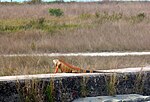Fort Zachary Taylor Historic State Park
Fort Zachary Taylor | |
Key West, Florida | |
| Coordinates | 24°32′48″N 81°48′38″W / 24.54667°N 81.81056°W |
|---|---|
| NRHP reference No. | 71000244[1] |
| Significant dates | |
| Added to NRHP | March 11, 1971[1] |
| Designated NHL | May 31, 1973[2] |
The Fort Zachary Taylor Historic State Park, also known simply as Fort Taylor, is a
History

1845–1900
Construction of the fort began in 1845 as part of a mid-19th century plan to defend the
The United States Army Corps of Engineers leased slaves from local slave-owners for construction of the fort and its neighbor Fort Jefferson. This resulted in an influx of enslaved peoples into the immediate area as, before the construction of the fort, there were no large agricultural ventures and thus not a high demand for slaves, marine salvage being the main industry. By some estimates, the number more than quadrupled from fewer than 90 enslaved people in Key West before construction to over 400 after.[3]
The fort's foundation consists of
Even before the onset of the
In 1898, the fort was reduced to two stories and Battery Osceola was added to the south casemate. The battery consisted of two 12-inch M1895 guns. The Civil War-era guns were used as fill, being buried within the new battery to save on materials. Battery Adair was added to the west casemate and included four 3-inch M1898 15-pounder rapid-fire rifles.[4]
The fort was heavily used again during the Spanish–American War (1898), World War I (1917–1918), World War II (1941–1945), and the Cuban Missile Crisis (1962).

1947–present
No longer of use to the U.S. Army, the fort was turned over to the United States Navy in 1947 for maintenance. In 1968, volunteers led by Howard S. England excavated Civil War guns and ammunition buried in long-abandoned parts of the fort to form what would be considered the nation's largest collection of Civil War cannons. Fort Taylor was placed on the National Register of Historic Places in 1971 and designated a National Historic Landmark in 1973. Due to the filling in of land around the fort, including the creation of an attractive stretch of beach, the park now occupies 87 acres (35 ha).
Truman Annex
The fort's land closer to downtown Key West became part of the Truman Annex to Naval Air Station Key West. It was originally a separate major installation known as Naval Station Key West and, until it closed in 1974, included a submarine base.
President
Naval Station Key West was decommissioned in 1974 as part of post-
Current uses
In addition to the role of the fort and its adjacent beach as tourist attractions, Fort Taylor is also the location of a number of annual events, including week-long Civil War reenactments.
Gallery
-
The fort as seen from the Gulf of Mexico
-
Outside view of the fort showing the moat
-
Sign overlooking the picnic area and beach
-
Shoreline and the Gulf
-
Inside the barracks
-
Cannons inside the fort
-
Iguana perched atop the outer wall of the fort
-
Cannons excavated from abandoned parts of the fort
References
- ^ a b "National Register Information System". National Register of Historic Places. National Park Service. March 13, 2009.
- ^ Fort Zachary Taylor Archived 2009-05-02 at the Wayback Machine at National Historic Landmarks Program Archived September 27, 2007, at the Wayback Machine
- ^ Smith, Mark A. (Spring 2008). "Engineering Slavery: The U.S. Army Corps of Engineers and Slavery at Key West". The Florida Historical Quarterly. 86 (4): 60–63. Retrieved 31 August 2022.
- ^ ISBN 9780991386536.
- . Retrieved 6 September 2022.
- ISBN 9780910923590.
- ISBN 9780813030197.
- ^ "21 Years Ago Today NSGA Key West was Disestablished". Station HYPO. 31 August 2017. Retrieved July 10, 2018.
External links
- Fort Zachary Taylor at Florida State Parks
- Florida Department of State: State Archives of Florida Online Catalog Architectural and technical drawings of Fort Zachary Taylor 1969-1980
- Historic American Buildings Survey (HABS) No. FL-283, "Fort Taylor, Whitehead Spit Vicinity, Key West, Monroe County, FL", 22 photos, 5 data pages, 2 photo caption pages, supplemental material












